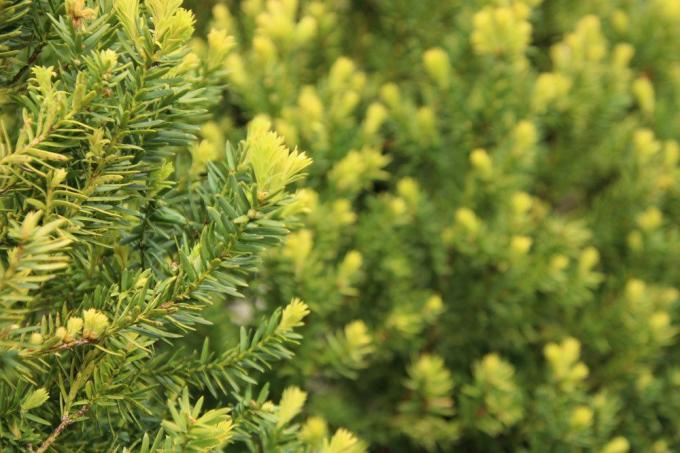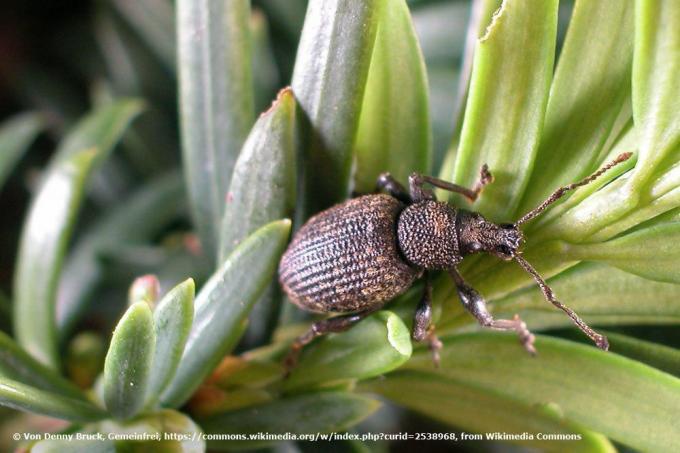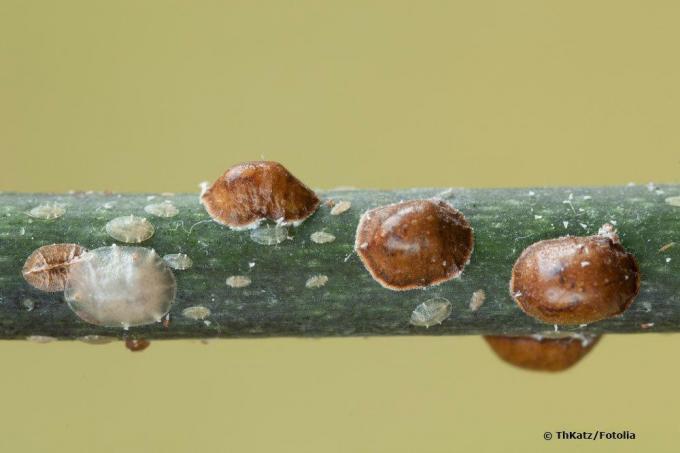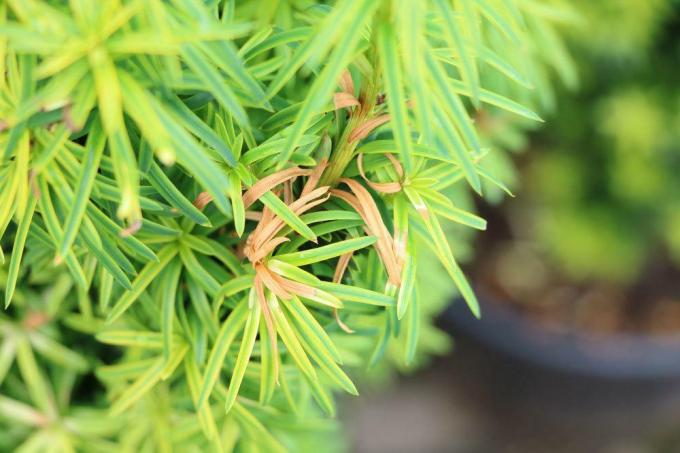
table of contents
- Yellow needles on the yew tree
- Unfavorable location
- Pest infestation
- Vine weevil and larvae
- Scale insects
- Bud gall mite
- Fungal attack
- Nutritional deficiency
The yew tree, also called Taxus baccata, is easy to care for. The plant rarely suffers from diseases or fungal attack. The evergreen plant has soft needles. These turn yellow every now and then, especially in young plants, but this is not a disease. Below is what to do when the yew tree grows yellow needles.
Yellow needles on the yew tree
Diseases are not the cause of yellow needles on the yew tree. The discoloration can be caused by
- unfavorable location
- Pest infestation
- mushrooms
- Nutritional deficiency
- normal aging
be evoked. Young plants that were only planted a year ago are mostly affected. You are not yet properly rooted in the ground. The plant begins to sprout and needs a lot of energy, water and nutrients for this. The plants cannot yet optimally absorb these important substances from the soil. They react with needle discoloration and with needle shedding. Most of the time, the plants on the trunk turn yellow from the inside out.
tip: Your yew hedge will turn green again next year, provided that the causes of the discoloration are removed. Yellowing is not a serious problem, but you should take appropriate measures to help your plants.
Unfavorable location
Yew trees are robust and can withstand any location. Shade and direct sunlight are no problem for older plants. However, young plants do not yet cope well with strong sunlight and turn yellow. This is also the case in winter with the winter sun. You should choose a location that is not too sunny. There should be enough shade around lunchtime. The location should be as sheltered from the wind as possible.
Help for young plants
If the yew tree is still young and it is turning yellow, you can help it with more water, even if yew trees do not really like waterlogging. The soil can be enriched with humus so that it becomes more permeable and holds moisture better. You promote soil life with a combination of a bacterial mixture (root stimulator) and organic soil fertilizer. This allows new radicles to form quickly. The plant can then absorb the water and nutrients better. In addition, you can remove the yellow needles by hand or easily remove Taxus baccata cut back.
Pest infestation
The black weevil, the scale insect and the bud bite mite are the most common pests that bother your yew tree. They become a problem with young plants, while an older yew hedge is largely robust against such pests.
tip: If you ensure biodiversity, you can largely prevent an infestation with pests. You should look out for a cocktail of worms, soil bacteria and mold, which ensure a biological balance and produce valuable humus.
Vine weevil and larvae
The black weevil is also known as the yew beetle. The larvae are white maggots and can nibble on the roots. When the yew tree has yellow needles, you should dig up the plants and examine them for infestation with black weevil larvae. The beetles are active from May. They are 9 to 11 millimeters tall and hide during the day. However, you can recognize an infestation with beetles when the earth around the trunk is a little churned. It is hardly possible to control the larvae and beetles with insecticides. Biological control is better.

Control with nematodes
Nematodes are also available to private individuals and are effective pest control measures. They offer several advantages:
- attack the larvae from the inside and eat them up
- multiply quickly
- are completely harmless
The nematodes love moist soil, which is why you should ensure that they are adequately watered. The biological control of the black weevil and their larvae can also be carried out with other beneficial insects:
- Birds such as chickens
- Soil bacteria
- Molds
Scale insects
The scale insects are active on the needles of the yew tree and ensure that they turn yellow. They are often difficult to determine. Scale insect infestation is likely if you see ants on the yew tree. The ants feed on the honeydew produced by the scale insects. In summer the scale insects form wax-like egg sacs on the needles and branches of the yew trees. They suck out the juice and can become a serious hazard as they multiply rapidly. It is therefore important that the scale insects are controlled thoroughly. A single louse can produce up to 1,000 offspring. Control with insecticides is not effective against scale insects either.

Biological control
You can effectively fight scale insects in a biological way. This can be done with various means:
- Cutting off affected branches
- Interruption of the ant trails
- Use of parasitic wasps
- Use of the ladybird Exochomus quadripustulatis
Ladybugs are also used in nurseries. They will also stay in one place for several years if the scale louse population persists. They can be used together with the parasitic wasps. Ichneumon wasps can penetrate the strong armor of the scale insects well.
Bud gall mite
The bud gall mite attacks the leaf and flower buds of the yew tree. An infestation can be recognized by the fact that the leaf buds are thickened to form galls around 6 to 8 millimeters in size and that sprout poorly. The scales of the flower buds are bent apart. The needles of Taxus baccata turn yellow. Later the growth is stunted and reminiscent of barbed wire. You fight the mites by removing the infected shoots. You can also use a plant protection product.
Fungal attack
The needles of the yew tree can also turn yellow due to fungal attack. You should think of a fungal attack if you do not see any traces of pests eating. Fungal infestation can have various causes:
- bad care
- too densely planted yew hedge
- wet weather
- Waterlogging
Fungi are difficult to control and often you can no longer help the plant. You should cut off all infected parts of the plant. You should loosen the soil and create a drainage. You can also counteract the fungal attack with fertilizers.
Note: Do not dispose of the infected parts of the plant on the compost, otherwise the fungi can spread quickly.

Nutritional deficiency
If the needles of your yew tree turn yellow, you should also think about a lack of nutrients. You should use a nitrogenous fertilizer. While nitrogen-containing fertilizers are possible until mid-August, you can also fertilize with potassium and phosphorus from mid-August.

